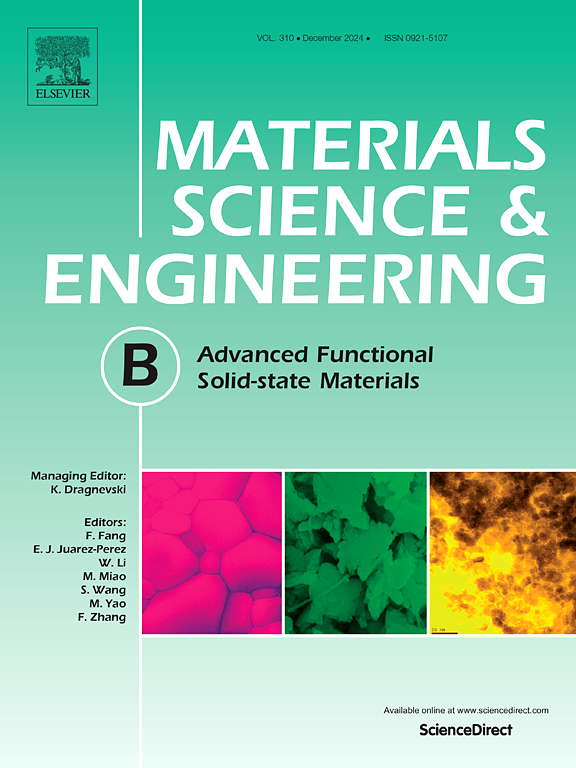Ultra-thin dielectric-metal-dielectric as metal electrode alternative for bifacial perovskite and organic solar cells
IF 3.9
3区 材料科学
Q2 MATERIALS SCIENCE, MULTIDISCIPLINARY
引用次数: 0
Abstract
Third-generation solar cells have garnered significant attention for their potential in building-integrated photovoltaics (BIPV), driving the need for advanced electrode materials that combine optical transparency with electrical conductivity. Here, the development and integration of an ultrathin dielectric/metal/dielectric (DMD) structure as a transparent electrode for bifacial perovskite and organic solar cells is reported. The optimised DMD configuration, consisting of a 2 nm bottom dielectric layer, a 6 nm metal core, and a 2 nm top dielectric layer, achieves an optimal balance of high electrical conductivity (∼8 Ω/□) and average transmittance in the visible wavelength range (∼69 %), enabling efficient charge extraction while supporting back-illumination. Comprehensive characterisation of the DMD electrode—including optical, morphological, and electrical analyses—demonstrates its superior stability and functionality under thermal and mechanical stresses. Device-level performance evaluations revealed bifaciality factors of 65 % and 42 % for perovskite and organic solar cells, respectively, with peak power conversion efficiencies of 13.02 % for perovskite and 7.61 % for organic configurations. External quantum efficiency for back and front illumination has opened up interesting insights into the carrier dynamics of the devices. Capacitance studies further elucidated the charge transport dynamics and device quality under bifacial operation. These findings position DMD electrodes as a promising alternative to conventional metal contacts, offering a scalable pathway to durable, high-performance bifacial solar cells for next-generation photovoltaic technologies and sustainable energy applications.
超薄电介质-金属-电介质作为双面钙钛矿和有机太阳能电池的金属电极替代品
第三代太阳能电池因其在建筑集成光伏(BIPV)方面的潜力而引起了极大的关注,推动了对结合光学透明度和导电性的先进电极材料的需求。本文报道了一种超薄介质/金属/介质(DMD)结构作为双面钙钛矿和有机太阳能电池的透明电极的开发和集成。优化的DMD结构由2 nm的底部介电层、6 nm的金属芯和2 nm的顶部介电层组成,实现了高导电性(~ 8 Ω/□)和可见光波长范围内的平均透射率(~ 69%)的最佳平衡,在支持反向照明的同时实现了有效的电荷提取。DMD电极的综合表征-包括光学,形态学和电学分析-证明了其在热应力和机械应力下的优越稳定性和功能。器件级性能评估显示,钙钛矿和有机太阳能电池的双面性因子分别为65%和42%,钙钛矿和有机太阳能电池的峰值功率转换效率分别为13.02%和7.61%。前后照明的外部量子效率为器件的载流子动力学开辟了有趣的见解。电容研究进一步阐明了双面操作下的电荷输运动力学和器件质量。这些发现将DMD电极定位为传统金属触点的有前途的替代品,为下一代光伏技术和可持续能源应用提供了耐用、高性能双面太阳能电池的可扩展途径。
本文章由计算机程序翻译,如有差异,请以英文原文为准。
求助全文
约1分钟内获得全文
求助全文
来源期刊

Materials Science and Engineering: B
工程技术-材料科学:综合
CiteScore
5.60
自引率
2.80%
发文量
481
审稿时长
3.5 months
期刊介绍:
The journal provides an international medium for the publication of theoretical and experimental studies and reviews related to the electronic, electrochemical, ionic, magnetic, optical, and biosensing properties of solid state materials in bulk, thin film and particulate forms. Papers dealing with synthesis, processing, characterization, structure, physical properties and computational aspects of nano-crystalline, crystalline, amorphous and glassy forms of ceramics, semiconductors, layered insertion compounds, low-dimensional compounds and systems, fast-ion conductors, polymers and dielectrics are viewed as suitable for publication. Articles focused on nano-structured aspects of these advanced solid-state materials will also be considered suitable.
 求助内容:
求助内容: 应助结果提醒方式:
应助结果提醒方式:


